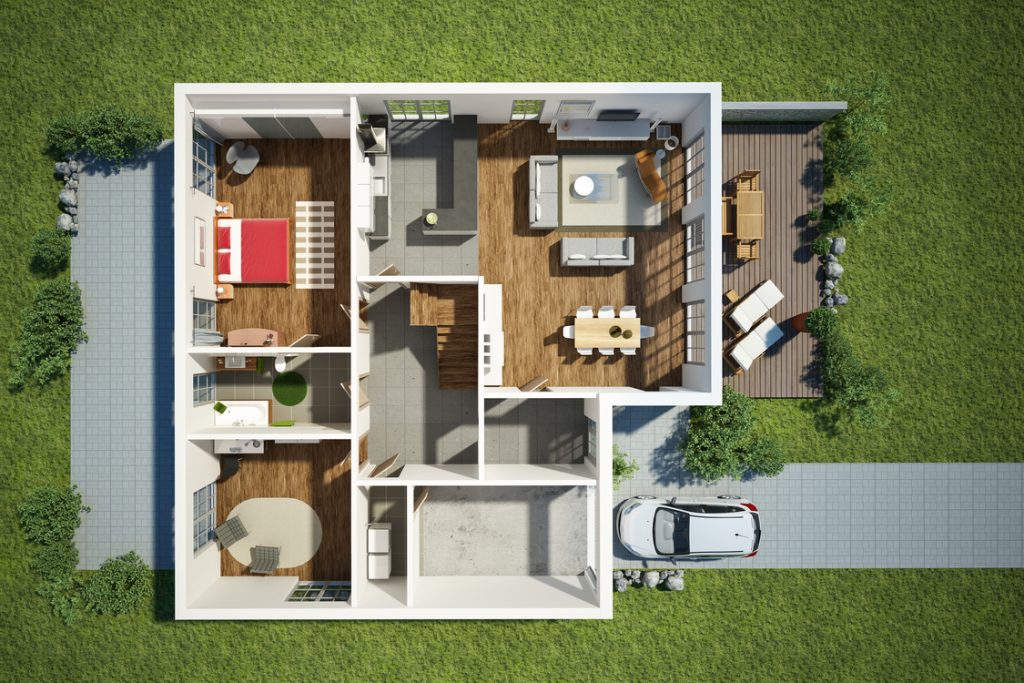Size Matters: What Square Footage is Right for You


What Comes First?
When planning for your new custom modular home, do you think about design and functionality first or do you think about square footage? The reality is that one drives the other. If you start looking at home plans based on square footage first then you haven’t really thought through the process and may end up with a home that is too big or too small. A home that is too large consumes more energy, takes more to clean and costs more to maintain, not to mention the higher taxes. Too small of a home can lead to cramped living, stress, and a quick trip down the path of selling and building another home soon!
The Realities
Home size is ultimately a culmination of many things. First are the realities:
Budget versus House Size – Looking at home plans is fun but for many, but budgetary limits will influence many choices. Lenders are taking longer for approvals and the banking rules have changed. One of the first steps in the building process is to work with several lenders and get a good feel for what your home building budget really is based on your credit. With low-interest rates, you may be pleasantly surprised at what you can really afford. Conversely, why suffer the disappointment and the waste of time planning if reality dictates a more conservative budget than you planned.
Needs versus Wants – When it comes down to final selections of what spaces are needed in the home prioritize early. With budgetary constraints choices will have to be made as to what is more important. Assign a priority to specific areas when choosing plans, and start with the one that most closely meets your lifestyle.
Things You Need to Ask Yourself
The first step in determining the ultimate size of a home is to examine your habits and your lifestyle. A custom home is built to support those that are living in it. Here are some questions to think about:
- How will you use the house? Is it a full-time residence or a retreat?
- How many people will be living there? Younger kids or older children?
- How often do you entertain?
- How often and how extensively will you use the kitchen?
- Do you spend your time in the bedroom or in the common living areas?
- Do you spend a lot of time outdoors? Is it on porches, patios, and decks or is it in the yard?
- How much do you want to spend on maintenance (both time and money) and taxes?
- How much storage do you need for the stuff you want to keep?
Feeling a Room’s Size
 Once you have good answers to the above you can start working with a proposed square footage for your custom modular home plan. Here is another important point when determining your homes size. It is more than the simple math of multiplying the length and width of each room. That doesn’t consider another important aspect of a room size, cubic footage. Think about the difference in the feel of a room if it has a 9-foot ceiling versus an 8-foot ceiling. How about a 25-foot high vaulted ceiling in a great room or cathedral ceilings in a breakfast nook. Be sure to consider both sizes when designing room space.
Once you have good answers to the above you can start working with a proposed square footage for your custom modular home plan. Here is another important point when determining your homes size. It is more than the simple math of multiplying the length and width of each room. That doesn’t consider another important aspect of a room size, cubic footage. Think about the difference in the feel of a room if it has a 9-foot ceiling versus an 8-foot ceiling. How about a 25-foot high vaulted ceiling in a great room or cathedral ceilings in a breakfast nook. Be sure to consider both sizes when designing room space.
Related: HOW MUCH DOES A NEW CAR COST PER POUND? (OR HOW MUCH ARE YOUR HOMES PER SQUARE FOOT?)
Another trap is thinking about your size requirement for a new home by comparing it to your previous home. Many older homes have very broken up floor plans with lots of hallways. Hallways are wasted living space. A 2,600 square foot home design from today can feel larger and be more functional than a 3,000 square foot home plan from the 80’s. If your lifestyle needs still require a larger home but you have to do it on a budget, think about ways to gain the maximum space at the best value. Basements offer large spaces at a fraction of the cost of main floor living. Bonus areas over garages can provide additional space at a fraction of the cost of designing in additional main floor living.
Additional Insights
Here are some additional insights as you begin the design process:
Resale Value – For example, a 1.5 bathroom home is less valuable than a 2.5 bathroom home. It may be cheaper now but think about how you use the home and how a future buyer may view it when looking at other homes in area when you are ready to sell.
Hobbies – Hobbies com in all shapes and sizes. Are you a woodworker with lots of materials and loud machines, a gamer with loud and noisy games, or a reader that enjoys quite areas. Make sure that the spaces can support your hobby and protect you from the noises of someone else’s hobby in the home.
Future Changes – Having a child, having more children, caring for an aging parent, and taking care in pets. These and other events happen all the time. What is your future plan for these and other events? How will it impact your home and the need for space?
Flexibility – If you is just the two you now but things change, can the hobby room turn into a bedroom or playroom? Can the bonus room over the garage become a home office? Having some extra useable space, if you can afford it, gives you room to change and grow under one roof.
Be Honest – Watching cooking shows doesn’t make you chef. If you are not a cook, don’t pay extra for a chef’s kitchen just because it looks great. That’s a big price just for looks. On the other hand, if you absolutely love grilling and entertaining outdoors, plan the budget for that nice outdoor space.
Once you have thought through what space you need for your lifestyle and your life plans, you are ready to start choosing house plans. Don’t underestimate the effort to find that perfect plan to start with. The great thing about using modular construction for your new home is the flexibility in design. You can even custom design your own home for the exact spaces and size requirements you need. That plan can be “modularized” and built using modular construction. Today’s modern modular construction process supports building today’s modern home designs.
The post Size Matters: What Square Footage is Right for You appeared first on Impresa Modular.




